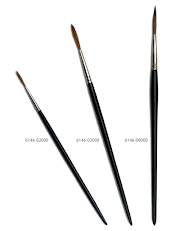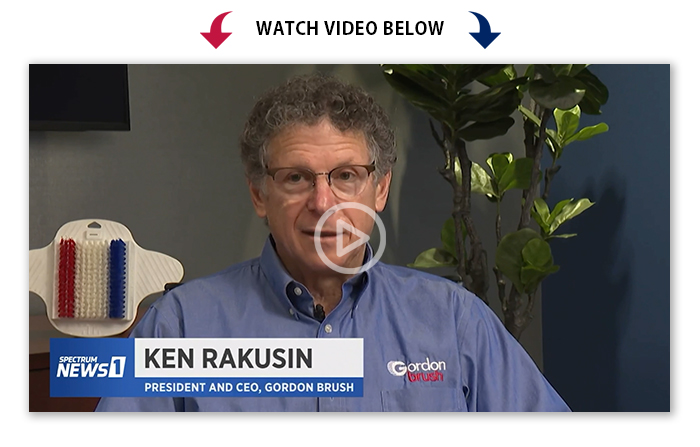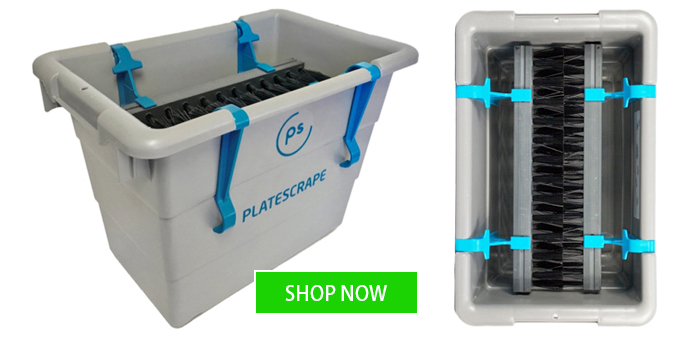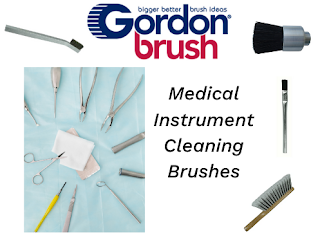| ||||||
Tuesday, May 2, 2023
Gordon Brush Mfg. Co., Inc., acquires Justman Brush Company
Tuesday, August 23, 2022
Best Watercolor Brushes of 2022
Industrial Watercolor Brushes Gordon Brush Mfg. Co., Inc. Offers
To get beautiful results when using watercolor as a medium, it is imperative to use the best watercolor brushes you can buy, as watercolor painting is delicate and unforgiving in nature.
Natural bristle watercolor brushes are soft and have a much better liquid-holding capacity than watercolor brushes made with synthetic hairs due to their fibrous anatomies, which excel at picking up and retaining water for lengths of time. Natural bristle watercolor brushes feel more like extensions of the artist's hand since they're more sensitive to shifts in pressure.
Gordon Brush® manufactures watercolor brushes in a variety of shapes, sizes, costs, and hair types. When purchasing most kinds of art supplies, watercolor paint brushes ultimately come down to personal preference and cost. The choice depends upon techniques you like to use and how the brushes feel in your hand.
Pure Red Sable round brushes are the most versatile and widely used brush for watercolor painting. A round brush comes to a fine point and its stroke is more organic. Their shape makes them ideal for small details, delicate lines and for broader strokes and washes. Brushes made for watercolor are specifically suited to deal with the fluidity and delicacy of watercolor paints and techniques.
A good watercolor brush should have the following characteristics: (1) it should not shed more than a couple of hairs; (2) it should balance well in the hand; (3) the handle should not feel too fat, (4) the brush should be durable; (5) the handle should not come loose at the ferrule; (6) there should be minimal warping or swelling of the wood over long periods of soaking; and (7) the brush must also have a quality called "snap", which allows the brush to respond and rebound quickly as the amount of downward pressure applied to it on the surface of the paper is varied.
Snap refers to the action of the damp brush hairs snapping upright after they are pulled down and sideways to the handle. This is most important, for this resiliency allows the artist to create a variety of paint widths within the same stroke of the brush, sometimes referred to as "action". A brush with no snap bends and does not rebound at all. This is not a good watercolor brush to use because it has no action.Gordon
Brush® manufactures three beautiful series of watercolor brushes:
0430-Series (Pure
Red Sable Round Pointer Watercolor Brushes)
These brushes are made with a short black lacquered handle with a nickel-plated ferrule. This series is ideal for one stroke painting as well as many other techniques.
0611-Series (Pure Red Sable Flat Watercolor Brushes)This series of brushes will retain its body when wet, which is the true test of a sable brush. The seamless nickel-plated ferrule and lacquered handle, make these brushes a great value. A flat brush is more angular, and the stroke appears straighter.
6146-Series (Pure Red Sable Scripto Liner Watercolor Brushes)These watercolor brushes are made with a black lacquered handle and a seamless nickel-plated ferrule. The extra-long liner is designed to hold a lot of paint so you can make thin lines longer.
So, if you want to be a famous
watercolor artist like Winslow Homer (an American landscape painter and printmaker,
best known for his marine subjects. He is considered one of the foremost
painters in 19th-century America and a preeminent figure in American art); Georgia
O'Keeffe (an American modernist artist known for her paintings of
enlarged flowers, New York skyscrapers, and New
Mexico landscapes. O'Keeffe has been called the "Mother of American
modernism"); Andrew Wyeth (an American visual artist, primarily
a realist painter, working predominantly in a regionalist style.
He was one of the best-known U.S. artists of the middle 20th century); or even Vincent
van Gough (a Dutch Post-Impressionist painter who posthumously
became one of the most famous and influential figures in Western
art history), you must purchase your watercolor brushes from Gordon
Brush®.
Call us today at 323-724-7777 or email us sales@gordonbrush.com for all your watercolor, industrial,
janitorial, electronic, and custom brush needs.
Monday, September 20, 2021
The Components of Artist Brushes
Whether you are a professional artist, grandmaster, or like to paint for fun, the artist brush is the tool you need create your masterpiece. There are several components that go into the making of an artist brush.
The
Filament
Filaments are the hairs or bristles of the brush. Because there are so many choices, it can be a bit overwhelming. Filaments are glued together at one end before being crimped into the ferrule.
Before deciding on the type of filament, it is necessary to determine your medium. Do you typically paint with oils, watercolors, or acrylics? Next, you’ll want to think about your level of expertise and what you wish to accomplish when painting.
One type of filament is a "bristle" brush. These are course and come in a variety of lengths. The shorter or stiffer bristles are usually used with thicker paints that require a lot of blending of the paints whereas thinner paints are best applied with longer or softer hairs that do not create texture.
Then there are natural filaments are made from the fur of an animal i.e. squirrel hair, sable, hog, badger, ox, pony, mongoose, mink, etc. They are very good at holding fluid because they are so absorbent. The natural brushes can be used for any medium whether it's oils, acrylics, watercolors, etc. They are super great for working with heavy bodied paints and work well on rough surfaces.
Natural brushes:
·
work well with oil paints –oil conditions
the bristles or hairs making them more pliable
·
work well with watercolors—really soak up
water and redistribute onto canvas
·
are not super compatible with acrylics
·
tend to hold shape well-good shape
retention
·
are more expensive
·
can become damaged by acrylic paints
·
tend to leave brushstroke marks—can be
good or bad depending on your intent
· animal rights and other environmental sustainability issues may be a concern for you
Synthetics filaments are man-made. They were developed to provide substantial use of the brush and can be used with any medium. Synthetic brushes are the workhorses for many an artist. Synthetic bristles have thicker filaments and are ideal for rough or hard surfaces such as ceramics and craft projects. Brushes that are "synthetic hairs" are softer and finer, hold a lot of liquid, and keep an excellent fine chisel edge. Synthetic hairbrushes provide a smoother stroke than natural bristle. They retain their stiffness and are very durable. They clean well with soap and water when used with acrylics or other water-based media. When used with acrylics, natural bristle brushes lose their stiffness, but they do hold more paint.
Synthetic
brushes:
·
are made of nylon or polyester or mix of
both
·
are budget-friendly
·
work well with acrylics, oils and
watercolors
·
tend to hold and release a lot more paint
·
splay more easily/faster
·
leave a smoother finish, and few to no
brush marks
·
don’t exploit animals
· are good for all levels of expertise
The Ferrule
A ferrule is the part that connects the filaments with the handle. Ferrules will determine the size of the brush, the numbers of filaments in the brush. The ferrule is crimped at one end to hold the filaments in place; the other end is glued onto the handle. The ferrules can be made with either metal or plastic.
The Handle
Handles are usually made of wood or plastic. Wood handles are made of hard wood and manufactured both domestic and overseas. They are made proportioned to balance in the hand and to give optimum control when painting. The wooden handles are lacquered to prevent the wooden handle from swelling and to help prevent the handle from crackling or warping when in contact with a fluid.
Plastic handles will not crack or warp, and as a result, they usually cost more. The length and diameter of a handle is important in your selection. Long handled brushes are used when working with an easel; oil painters prefer long handles for this reason. Short-handled brushes are for working on a table and preferred by acrylic, watercolor, and craft painters. Large diameter brushes aids those with hand pain but they can be used by anyone. Different brushes tend to fit differently in the hand, thus giving good control when painting.
Choosing the right type of brush for your project is critical. Brush types include:
Flats
Flats are brushes with a straight chisel edge and square shaped filaments. These can be known as shaders if they’re in smaller sizes and washes/glazes if in bigger sizes. Large areas are painted with a wash/glaze brush whereas smaller flats are used for small areas of painting.
Round
Round brushes have a large diameter of the ferrule, more so than a liner, which can be used for applying thick to thin lines, filling in odd-shaped areas, painting details and work great for lettering. Liners don't hold as much paint as a round, however, they are super great for creating lines or curves. Script liners are similar to liners, but the filaments are much longer and hold more paint. A round brush tapers to a pointed tip. Angle brushes are filaments that have been cut on an angle. These are excellent to use in small or curved areas of the painting.
Filbert
Brushes with oval shaped filaments are known as filberts in smaller sizes and oval wash in larger sizes. Both shapes can be used for base coating, stroke work and more. There are filbert combs, filbert wash and more.
Mop
Mop brushes are great for blending and smoothing out small areas. They're also ideal for applying powdered pigments.
Specialty
Specialty brushes are used for certain techniques and garner their own results: fan, deerfoot, scumbler, mops and more.
Other paint brush characteristics to
consider are:
Brush Width
Brushes
come in a wide variety of widths, commonly ranging from about 1 inch to 5
inches. You can apply more paint with a wider brush, but you should always
match the brush width to the surface being painted.
Bristle Shape
Most
paintbrushes available today are square-cut brushes. They are perfect for
holding and laying paint onto virtually any surface. However, square-cut
brushes don't provide as much control when painting into corners, up to
adjacent surfaces, or along narrow edges or surfaces. For more precise control,
use a sash brush, which has its bristles cut at a slight angle. Sash brushes
are particularly well-suited for cutting in around the perimeter of a room.
Bristle Tips
Better quality brushes have bristles with flagged, or split, ends. Flagged bristles hold more paint and spread paint more smoothly. Some brushes, especially sash brushes, have tipped ends, which should not be confused with flagged ends. Tipped brushes come to a point; they're not cut flat and straight, as is a standard brush.
Gordon Brush® manufactures 255 artist
brushes with a wide variety of fill material, handle material, shapes, types,
styles, and sizes. Whether you are a professional artist,
grandmaster, or like to paint for fun, Gordon Brush® has the perfect Americanmade artist brush for your project. Contact us at 323-724-777 or sales@gordonbrush.com, for one
of our stock brushes or if you need a custom brush for any project or
application.
(for a full read of the original article, please visit https://issuu.com/brushwaremag/docs/21v5_brm-digital?fr=sNjU2YTQxNDc3OTU - pages 25-27)
Monday, September 13, 2021
More About the Nylon Fill Material
The specific application for a brush or how it is going to be used, determines the components that go into making a brush. The main structural components are the fill material and the handle, block, or frame material. Fill and handle material can be of many different substances. Nylon is one such fill material.
Nylon fill material is used as a brush because it is exceptionally tough, strong, flexible, has excellent elasticity, is durable, abrasion and chemical resistant, and able to withstand extreme heat. Nylon, an organic thermoplastic, comes in a variety of filament types. Common nylon filaments are nylon 6, nylon 66, nylon 610, nylon 612, nylon 11, and nylon 12. Each of the different filaments has a different abrasive capacity and grit. The properties of nylon brushes are related to their bristle grade, length, and diameter.Handle, block, or frame material is either wood, plastic, or metal. Some brushes do not have a handle. These types of brushes attach directly to power tools or cleaning equipment. These classes of brushes include cylinders, large flat ovals, wheel shapes, centerless cylinders, cup brushes with or without a shank, and others.
Nylon can be adapted, shaped, and configured for many different types of brushes such as, scrubbers for floor machines, cylinder brushes, wheel brushes, cup brushes, twisted-wire-brushes, strip brushes, and hand brushes and have many different uses from ones that can clean your teeth to ones designed to remove rust, paint, grime, and contaminants. The wide use of nylon brushes is due to their many grades, grit types, configurations, and mechanical properties.
Nylon brushes can be used for many different purposes such as abrasion, washing, cleaning, various applications including, painting, applying coatings, getting into hard-to-reach areas, polishing, as a static eliminator, pipe cleaning, conveyors, and wood distressing.
These brushes are essential in many industrial processes such
as aerospace, agriculture, automotive, firearms, food processing, medical
supplies and instruments, and glass processing, the military, electronics,
printing, among others. Regardless of the operation or application, a nylon
brush is used to clean, finish, coat, or remove static and contaminants.
To read more from the original article, check out our published piece on the IQS Directory here: https://www.iqsdirectory.com/articles/brush/nylon-brush.html
Thursday, May 6, 2021
Gordon Brush Mfg. Co., Inc., Creating Jobs in the City of Industry
|
|
|
|
Friday, March 19, 2021
Gordon Brush Acquires An Interest in P.S. Creations
|
|
Monday, February 22, 2021
Medical Instrument Cleaning Brushes
Medical instrument cleaning brushes are essential
to prevent cross-contamination and infection. That's why it is imperative to
use the right brush to clean instruments thoroughly. Hospital personnel should
be familiar with the length and gauge of the brush, and which bristle types
should be used on each specific device.
Fill Material
Used for Medical
Instrument Cleaning
- Nylon –Nylon
is the most durable synthetic filament available. It has excellent abrasion and bristle bend recovery. Nylon resists most acids and will not
scratch most surfaces.
- Polypropylene –
Polypropylene is one of the most chemically resistant synthetic materials and is resistant to most acids and bases. Since it does not absorb
moisture, it resists fungi and bacteria, sheds dirt easily, and it's easy
to clean.
- Stainless Steel – Stainless steel is highly resistant to corrosion, heat, and chemicals. It should not be used on insulated or coated instruments because it can damage them. Stainless steel is designed to clean instruments that have serrations or box locks.
Manual
cleaning is recommended for delicate instruments and devices, such as
microsurgical instruments, lensed instruments, power equipment, and other
instruments that cannot tolerate an automated cleaning process. For
these delicate instruments, it is best to use a nylon fill brush first. If
debris still remains on the instrument, then use a stainless steel brush.
Stainless steel brushes are designed to
remove debris, stains, and stubborn bio-burden that the nylon brush cannot
remove. Stainless steel is intended to be used on bone files, needle holders,
burs, hemostats, reamers, scissors, serrated vascular instruments and
orthopedic instruments.
Medical instruments come in many shapes
and sizes, so it is imperative for SPDs (Sterile Processing Departments) to
have a full assortment of brushes specifically designed to clean them properly.
For example, a brush too small for a cannula may result in inadequate cleaning,
since it does not provide the necessary scrubbing action. Conversely, using a
brush that is too large makes the bristles lay against the wall of the lumen.
Even worse, the brush may become stuck inside the channel, ruining both the
device and the brush. The bristle should be able to make
contact with all the walls of the cannula at the same time.
Gordon Brush® manufactures a wide variety
of medical instrument cleaning brushes. These include: medical applicator brushes; medical micro spiral brushes; ring handle medical spiral brushes; thread cleaning brushes; medical toothbrush style brushes; and block brushes; hand scrubbing brushes; vacuum brushes; and other instrument cleaning brushes that are both straight and curved.
If
a brush exists, we have it…If it doesn't, we'll make it!
Call us today or search and shop for medical instrument cleaning brushes now!













